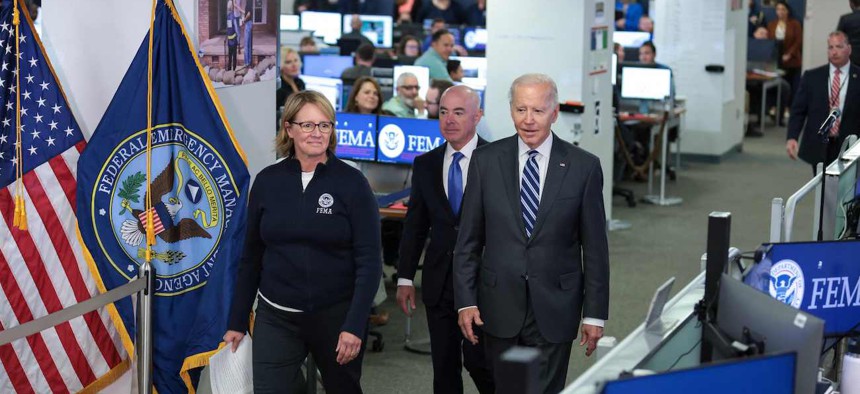
Federal Emergency Management Agency Administrator Deanne Criswell (left), Homeland Security Secretary Alejandro Mayorkas (center) and President Biden during a visit to FEMA headquarters on Sept. 29, 2022. OLIVER CONTRERAS/AFP via Getty Images
FEMA Wants to Confront Growing Challenges With More Personnel
The Biden administration is expecting unique challenges this disaster season, and FEMA wants to do more with more.
The Biden administration is hoping a significant increase in its emergency response personnel will help it improve preparations and recovery efforts before and after disasters strike, particularly as storms approach with less warning and affect those with less experience in handling them.
The Federal Emergency Management Agency is looking to grow its workforce by the equivalent of nearly 1,500 full-time employees in fiscal 2024—a figure that includes both its regular, permanent staff and its corps of reservists. Combined with the 1,200 it hopes to add in the current fiscal year, FEMA is looking for a 20% surge in its staffing levels from the end of September.
To date, FEMA said, it has struggled to grow its workforce that is qualified for incident management beyond attrition. Only about 73% of its employees are trained and ready for deployment at any given time.
FEMA Administrator Deanne Criswell, speaking at a conference in New Orleans on Monday, said in addition to the growth in frequency and severity of natural disasters during her tenure, her agency is facing a unique challenge in the huge population shifts that have occurred since the COVID-19 pandemic.
“What concerns me the most is the fact that we actually have a large amount of our population that has moved into different areas over the last several years,” Criswell said. “We have a number of individuals that live in communities that experienced severe weather threats that maybe they have never experienced before.”
FEMA and its local partners will have to work with those who have moved into the Gulf Coast region and have never gone through a hurricane, for example, to ensure they are properly prepared and understand what to expect. To confront those changes, coupled with more extreme weather events, Criswell said FEMA is developing new strategies. Knowing it sometimes has less lead time than it has historically from when a storm develops to when it makes landfall, the agency is working on improving its technology so it can get resources into communities more quickly. It is also developing "culturally competent messaging" to target specific audiences.
“With this increase in the types of severe weather events that we are seeing, we as an emergency management community, we have to adapt,” Criswell said.
As FEMA looks to boost its workforce to carry out its new and added responsibilities, it will have a tool that will make its work more attractive to prospective applicants. President Biden last year signed into law the Civilian Reservist Emergency Workforce (CREW) Act to help it address critical staffing shortages and a recent wave of departures. The law ensures that FEMA reservists, who are only paid by the agency while deployed to a disaster, receive job protections even if they are unable to give notice before deploying to a disaster response. They previously lacked those protections, which lawmakers, Criswell and the reservists themselves said were decimating recruiting and retention efforts.
The law will “enable FEMA to recruit and retain reservists from a broader and more experienced talent pool of individuals seeking public service opportunities, including some of the most in-demand FEMA missions, such as IT, logistics, supply chain management, and other critical mass care roles,” the agency said in its budget documents.
FEMA’s cadre of more than 13,000 reservists have been stretched thin in recent years, as they deployed to not just hurricane and wildfire response but also pandemic and border obligations. The agency noted that President Biden proposed creating a southwest border contingency fund so it can “support critical border management requirements” without tapping into its own financial resources.







